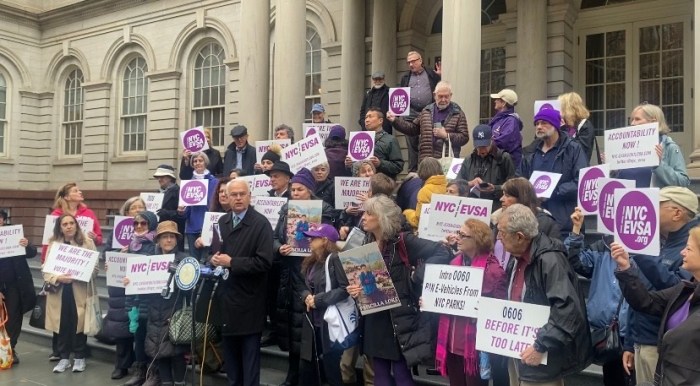Billions For Infrastructure Upgrades
The state Department of Environmental Conservation (DEC) and the city Department of Environmental Protection announced last Tuesday, Mar. 13, an agreement on an enforcement order to improve the overall water quality in New York Harbor waters.
Under this agreement, the city will invest approximately $187 million over the next three years and an estimated $2.4 billion of public and private funding over the next 18 years to install green infrastructure technologies to manage stormwater before it enters the city’s combined sewer system.
The city maintains the flexibility to prioritize green investments in areas of the city that will benefit most from the resulting reductions in combined sewer overflows.
“[The] DEC and New York City worked collaboratively to develop an innovative and cost-saving approach to water quality problems in New York Harbor,” DEC Commissioner Joe Martens said. “New York City’s use of green infrastructure to achieve water quality goals at lower cost to ratepayers should serve as a model for other large, urban communities in New York State and the nation. Green infrastructure beautifies the urban landscape, a benefit long sought by environmental justice stakeholders.”
“Mayor [Michael] Bloomberg has made the revitalization of the waterfront and the harbor signature priorities for his administration, and this plan commits $1.5 billion to green infrastructure that will improve water quality, beautify the cityscape, and save New Yorkers billions of dollars over the next 20 years,” Deputy Mayor for Operations Cas Holloway added. “I want to thank Gov. [Andrew] Cuomo and DEC Commissioner Joe Martens for making this plan possible by working with us to set a new course for waste water infrastructure that will benefit the city for years to come.”
“It is now an official green light for the groundbreaking NYC Green Infrastructure Plan,” said DEP Commissioner Carter Strickland. “This multi-pronged approach strikes the perfect balance to meeting the goal of improving the water quality of New York Harbor: gray infrastructure where it is still cost effective and cutting edge green technologies that not only absorb the water where it lands, but enhance the local quality of life by providing shade and beautifying the city. This agreement, which will be implemented in partnership with numerous city agencies and environmental stakeholders, truly represents a breakthrough in how we re-envision stormwater management and I want to thank the state Department of Environmental Conservation for working with us to make it happen.”
New York City, like other older urban communities, is largely serviced by a combined sewer system where stormwater and wastewater are carried through a single system. During heavy storms, the system often reaches capacity and must discharge a mix of stormwater and wastewater -called a combined sewer overflow (CSO)-into New York waterbodies.
If the overflows were not discharged, the city’s wastewater treatment plants would be flooded and unable to treat wastewater.
Through a mix of cost-effective gray infrastructure and cutting-edge green infrastructure, the agreement aims to significantly reduce sewer overflows into waterways through a combination of traditional and green infrastructure practices over the next 18 years. The city estimates that approximately 1.5 billion gallons of CSO flows will be removed annually by 2030 through the application of green infrastructure.
Green infrastructure, such as green roofs and porous pavement, improves harbor water quality by capturing and holding stormwater runoff before it enters the sewer system and contributes to CSOs.
As part of the agreement, the state and city have resolved all outstanding compliance issues associated with the consent order. The modified order requires the city to complete $1.4 billion in cost-effective gray infrastructure substitution projects to improve the city’s collection system performance. These substitute projects will save the city taxpayers $1.4 billion from the original tanks and treatment plant expansions, required by the consent order, while providing equivalent water quality benefits.
The state has also agreed to defer decisions on the need for significant gray infrastructure projects, such a storage tunnels or holding tanks, to achieve water quality goals in Newtown Creek and Flushing Bay until completion of the green infrastructure demonstration projects. This will defer approximately $2 billion in capital projects.
This approach provides an opportunity for DEP to incorporate green infrastructure into its CSO long-term control plans, which are aimed at achieving full water quality compliance, and will be developed with public input between 2013 and 2017. There is potential for future significant savings to city rate payers should green infrastructure prove effective in these watersheds.
Under the provisions of the agreement, the city agrees to pay a $200,000 penalty; provide $150,000 to support a water quality evaluation of the Hutchinson River; and fund $5 million in environmental benefit projects, including supplemental funding for two neighborhood-scale green infrastructure demonstration projects and for DEP’s existing green infrastructure grant program for the next three years.
The city will also accelerate the 26th Ward gray infrastructure substitution projects, and is subject to an additional $1 million penalty if that schedule is not met.
The modified order puts into place the elements of a green infrastructure adaptive management approach. Over the next 18 years, the city will control the first inch of rain from 10 percent of the city’s impervious surface with green infrastructure. The order requires five-year incremental milestones to meet that goal, and annual reporting on progress. The $187 million in public funds will be used toward the achievement of the first five-year target.
Examples of green infrastructure projects include: blue roofs and green roofs, which use mechanical devices or vegetation to slow roof water from draining too quickly and overwhelming sewers; porous pavement for parking lots that allows water to seep through it and be absorbed into the ground rather than running-off into the sewer system; tree pits and streetside swales for roadways that allow water to pool in underground holding areas until it can dissipate in the ground or transpire through plants; wetlands and swales for parks; and rain barrels in some residential areas.
City Council Member James F. Gennaro, who wrote a letter to the DEC in support of the change in its agreement with the city that enabled the Green Infrastructure Plan to go forward, said, “This agreement locks in place an ambitious, adaptive, intelligently designed stormwater management plan through the next 20 years. It will establish enforceable milestones and a budget to implement it. The plan will offer better stormwater management at lower costs to the public. DEP projections indicate that the Green Infrastructure Plan will reduce combined sewage outflow volumes by nearly two billion gallons more per year than the previously required all-gray infrastructure plan-and all that for $2.4 billion less in public spending. It’s particularly important for the state and city to leverage innovative, costeffective solutions like these when there are competing social needs and taxpayer dollars must deliver more services for less.”
For more information, visit www.nyc.gov/dep.


































